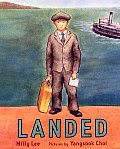By Tami Morton, Lois Knezek, & Betty Reily, University of North Texas, Denton, TX
Children’s and adolescent literature is a wonderful starting place for young readers to begin considering and understanding experiences of immigration to the United States. Many talented authors have provided characters with whom many children and young adults can relate.
 Milly Lee (2006) introduces readers to Sun Lee, a 12-year old Chinese boy, who immigrates to America in the book Landed. Sun’s parents believe that there are more opportunities for him in the United States, so they prepare him for his departure. Though Sun is a bit nervous, he knows that his older brothers went to America once they reached the age of 12, so he was ready and willing to make the trek. Sun’s immigration to America was totally voluntary. In the story, the description of Sun’s preparation, traveling experiences, as well as the extended time he remained at Angel Island before he officially “lands,” were a testament to bravery. It was clear at the end of the story that Sun really was happy and proud to be in the United States. Though this story took place in the 1930’s, it provides readers an opportunity to think critically about the entrance of Chinese people who wanted to come to America.
Milly Lee (2006) introduces readers to Sun Lee, a 12-year old Chinese boy, who immigrates to America in the book Landed. Sun’s parents believe that there are more opportunities for him in the United States, so they prepare him for his departure. Though Sun is a bit nervous, he knows that his older brothers went to America once they reached the age of 12, so he was ready and willing to make the trek. Sun’s immigration to America was totally voluntary. In the story, the description of Sun’s preparation, traveling experiences, as well as the extended time he remained at Angel Island before he officially “lands,” were a testament to bravery. It was clear at the end of the story that Sun really was happy and proud to be in the United States. Though this story took place in the 1930’s, it provides readers an opportunity to think critically about the entrance of Chinese people who wanted to come to America.
Continue reading

